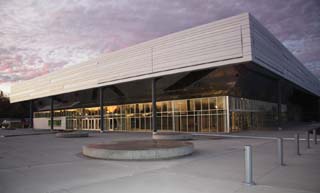|
Subscribe / Renew |
|
|
Contact Us |
|
| ► Subscribe to our Free Weekly Newsletter | |
| home | Welcome, sign in or click here to subscribe. | login |
Construction
| |
 |
December 18, 2008
Arena goes green with help of a $3M carrot
City of Kent

Witham
|
When ShoWare Center opens its doors on Jan. 2, it will be one of the first sports and entertainment facilities in the United States to be certified LEED silver by the U.S. Green Building Council.
Why LEED? Not only was it the right thing to do, but it offered the city an opportunity to secure additional funding. When the state Legislature provided $3 million for the $84.5 million facility, it required that the center be LEED silver. With environmental stewardship being very important to the Kent City Council, staff decided to go beyond the state’s minimum requirement.
Unsure of how to proceed, the city brought in Paladino and Co., a Seattle-based green building consultant. LEED silver certification requires a minimum of 33 points in six different categories, but the city decided to do more.
With several construction-phase credits still pending, the building is within striking distance of the 39-point gold rating. The building’s final LEED rating will be based upon USGBC’s certification process following construction.
While building green costs significantly more up front, the city will see a cost savings in the long run. LEED buildings cost less to operate and maintain, and are energy and water efficient. ShoWare Center being among the first of its kind in the country, civic pride was a big incentive too.
The following highlights how ShoWare Center earned points in each of the LEED rating system categories:
Sustainable sites
Forty-four drivers with low-emitting/fuel efficient vehicles, and 45 carpools or vanpools will have dibs on the best on-site parking spaces. Up to 50 bicycle commuters can store their bikes, and employees who bike to work can shower when they arrive.
The site design ensures that the quality and quantity of stormwater leaving the site is the same as when it was a soccer field, minimizing the impact to the nearby Green River. The lighting around the building was sensitively designed to reduce light in the night sky, minimizing impacts on the adjacent neighborhood and habitat areas.
Water efficiency
All of the water fixtures in ShoWare Center are low flowing, and the toilets are dual-flush, where the user pushes the lever up for solids, and down for liquids. Also, ShoWare Center’s landscaping is native to the region and will not require any watering once the plants are established.
Savings from these water-efficiency efforts are expected to exceed 40 percent from a typical building, equaling over 380,000 gallons of water saved per year.
Energy and atmosphere
Energy-efficient lighting, heating, cooling and ventilation systems and ice-making equipment will reduce the predicted energy use by more than 37 percent compared to national standards.
Materials and resources
During construction, advanced planning and attention to detail resulted in the recycling of more than 90 percent of construction debris.
The project team used locally harvested and manufactured products to reduce use of natural resources and minimize material transportation. The use of more than 50 percent Forest Stewardship Council-certified wood ensured that forests providing wood to the project are managed sustainably.
Use of low-mercury lamps throughout the project reduces the impact of this toxic substance. SMG-Savor, the food and beverage provider, recycles waste, uses non-petroleum-based packaging and provides healthy, locally produced and sustainably harvested food.
Indoor air quality
ShoWare Center has sensors that deliver fresh air based on the number of people in the building. Carbon dioxide-driven ventilation will ensure the air doesn’t get “stale.”
Low volatile-organic-compound paints and adhesives were used on the building’s interior to minimize indoor contaminants that exacerbate asthma and other respiratory problems. Also, low-emission carpets and composite wood products with no added urea formaldehyde were selected.
The ongoing use of green cleaning products and procedures will maintain a healthy indoor environment for event attendees as well as employees.
Innovation and design
The project team members worked together to identify green measures and to minimize the overall project and operational costs for the facility.
For instance, they figured out how to capture the excess heat that is rejected from the ice-making equipment to warm the ground under the ice rink to maintain the integrity of the foundation. This same heat is also used to melt the ice in the Zamboni pit.
Aside from the bright green accent color inside the building, guests will likely be unaware they’re inside a “green” building until they watch the educational videos around the concourse and on the center scoreboard. Starring the Seattle Thunderbirds mascot, Cool Bird, the clever vignettes are designed to entertain guests while also informing them of the building’s innovative green features.
Michelle Witham is the community and public affairs manager for the city of Kent.
Other Stories:



